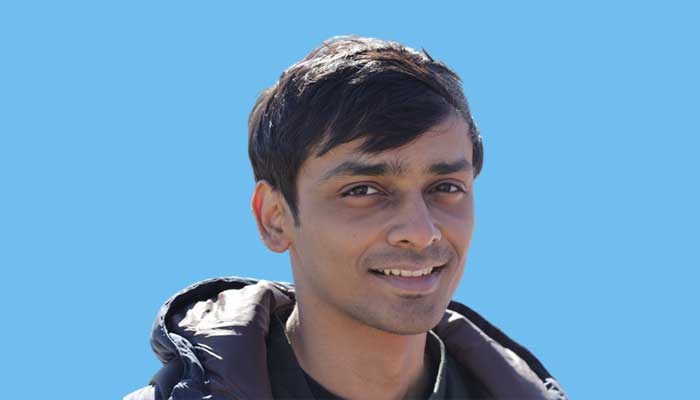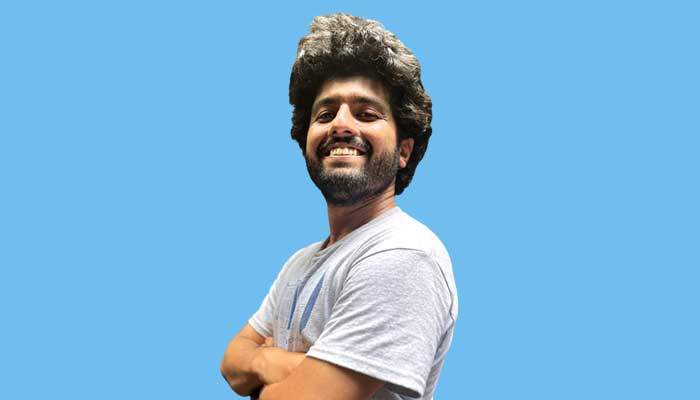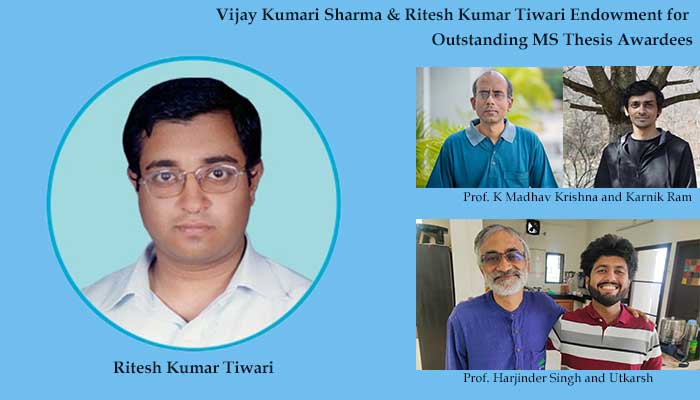Theses from the Robotics Research Centre (RRC) and the Centre for Computational Natural Sciences and Bioinformatics (CCNSB) win the award for the year 2021 and 2022 respectively.
The Vijay Kumari Sharma and Ritesh Kumar Tiwari Outstanding MS Thesis Award has been constituted through the setting up of a generous endowment fund to honour the memory of Ritesh Tiwari who began as an MS student under Prof. Kamal Karlapalem and displayed immense passion for research. Ritesh’s main area of research interest was in the domain of information security and particularly in attack resilient protocols, access control, security in workflow management systems and security architectures for the semantic web. His research work was supported by Microsoft Research PhD fellowship. He also received the IEEE Best Student Paper Award in Services Computing in 2006-07 for his work on SLA Driven Process Security through monitored E-contracts. Ritesh was sadly diagnosed with leukaemia in 2007 and succumbed to it in October 2009 after waging a valiant battle. The Outstanding MS Thesis Award that has been set up by Ritesh’s mother Smt. Vijay Kumari Sharma recognises the most outstanding MS Thesis defended during the academic year with a medal and a certificate. It includes a contribution made in the name of the awardee to support financially needy undergraduate students at the institute.
Dec 2021 Awardee
“We received many strong nominations and it was a difficult choice,” remarks Prof. Kamal Karlapalem. For the year December 2021, out of the six recommendations received from faculty, the selection committee chose MS thesis by Karnik Ram who was guided by advisor Prof. Madhava Krishna. The thesis titled “RP-VIO: Robust Plane-based Visual-Inertial Odometry for Dynamic Environments” proposes a distinctive solution for reliably tracking the motion of a camera in dynamic environments. “Tracking a camera’s motion, otherwise known as visual odometry, is fundamental to many applications in robotics and extended reality where it is necessary to maintain spatial context,” explains Karnik, while elaborating that dynamic environments refer to crowded spaces containing many moving vehicles and/or people that are especially common in Asian countries. However, despite being an impactful and challenging problem at an interesting intersection of optimization, linear algebra, and geometry, it has not been addressed satisfactorily in the literature. While several visual odometry methods have been developed, their performance degrades significantly while operating in dynamic environments.

Unique Factor
“After experimenting with existing methods, we identified their initialization phase to be the most brittle, and proposed to detect and track only planar surfaces in the scene – surfaces such as roads and walls, that are common in everyday environments. These are largely static and provide useful geometric constraints. This approach is simple and versatile, and differs from existing approaches by directly tracking static regions in the scene rather than attempting to track dynamic objects that can vary across scenes,” states Karnik. This method was implemented in both the initialization and tracking phases of a state-of-the-art visual-inertial odometry algorithm, a commonly used type of visual odometry algorithm that combines camera and IMU (inertial measurement unit) data. In addition to this, after noticing the limitations of existing datasets, the team built their own simulated dataset for a more systematic evaluation of visual odometry algorithms in dynamic environments.
Impact
According to Prof. Krishna, Visual Inertial Odometry in dynamic scenes creates an immediate and direct Impact for a wide cross section of the robotic vision community. These include academics, research labs, startups and companies engaged in indoor, outdoor, aerial robotics, warehouse robotics and vision based technology development. “Karnik’s thesis has evinced interest amongst companies working in these areas such as Mathworks and the Defense Labs,” he says. Additionally, the work has strengthened the Robotics lab’s position as the leading research group in localization and mapping at the national level.
Recipient of Award For 2022
For the year 2022, out of nine nominations received, Utkarsh Azad’s thesis titled ‘A Fine Grained Approach to Computational Problems On Noisy Intermediate-Scale Quantum Hardware’ bagged the Outstanding MS Thesis award. Ably guided by Prof. Harjinder Singh, Utkarsh’s thesis addressed problems which are at the confluence of Physics, Chemistry and Computer Science. In essence, the thesis answers three key questions for near-term quantum computers, that are popularly referred to as noisy intermediate-scale quantum (NISQ) hardware – what useful problems can be solved by them?, how to efficiently model and verify their results classically?, and how to improve their overall performance? While the problems in themselves are novel and essential because their answers fill the gaps in developing early-fault tolerant quantum computers, the solutions proposed were equally innovative because they unified traditional (and theoretical) quantum information and quantum computation fields with more recently developed (and practical) quantum programming and quantum software areas.

Pioneering Work
With this work, the researchers have notched up many firsts. They built a software simulator called Akaash for executing noisy quantum circuits that was one of the first density-matrix simulators and the first library to support all kinds of noise models for superconducting quantum hardware. Incidentally Aakash was part of India’s Quantum-Enabled Science & Technology (QuEST) initiative and is the simulator used in the QSim: Quantum Computer Simulator Toolkit launched by the Ministry of Electronics and Information Technology (MeitY) in 2021. It is currently being used to introduce quantum computing to undergraduates and graduate students across India. Their research group is also the first to perform transition state search calculations on quantum hardware with the help of a new variational algorithm. They developed one of the first visualisation libraries for parameterized quantum circuits called qLEET, motivated by the existing software libraries for deep learning models. It enabled researchers and users to visualise properties such as expressibility and entangling power and is still the only library offering these features.
Impact
“The method we developed for extracting higher-order gradients is currently implemented in PennyLane, a popular quantum programming library that offers a differentiable quantum computational chemistry workflow,” reveals Utkarsh adding that for developing the qLEET library, he was awarded a grant of 4000 USD by the Unitary Fund organisation that helps create a quantum technology ecosystem. In addition to this, the noise-aware procedure developed to design optimal qubit interaction in the NISQ architecture was proven useful in building QRoute, a reinforcement learning-based qubit routing method for quantum circuits. “At the national level, this work (as well as the papers published based on this) is the first-ever work in the area with a global impact,” states Prof. Singh. In April 2023, a year after Utkarsh graduated, the Indian government launched the National Quantum Mission in a bid to boost the use of quantum mechanics to build advanced sensors. “It was the first ever attempt from our institute as well to exploit quantum computing facilities offered by IBM and other companies like Rigetti,” specifies Utkarsh. It also led them to build collaborations with other premier research institutes such as a joint MeitY proposal with IIT-Roorkee and CDAC Hyderabad as well as an MoU with Riken, Japan. Based on the work done as part of the thesis, Utkarsh was invited to mentor students at various quantum computing events, such as IBM Quantum Challenges, Qiskit Global Summer Schools, NYU Abu Dhabi Hackathon for social good and so on. “The paper on quantum chemistry published on the basis of work described in the thesis has established our presence in the area as leading experts,” says Prof. Singh concluding with, “In my humble opinion, with the number of applications discussed, this thesis may be adequate for a PhD. degree in most places”.



Next post